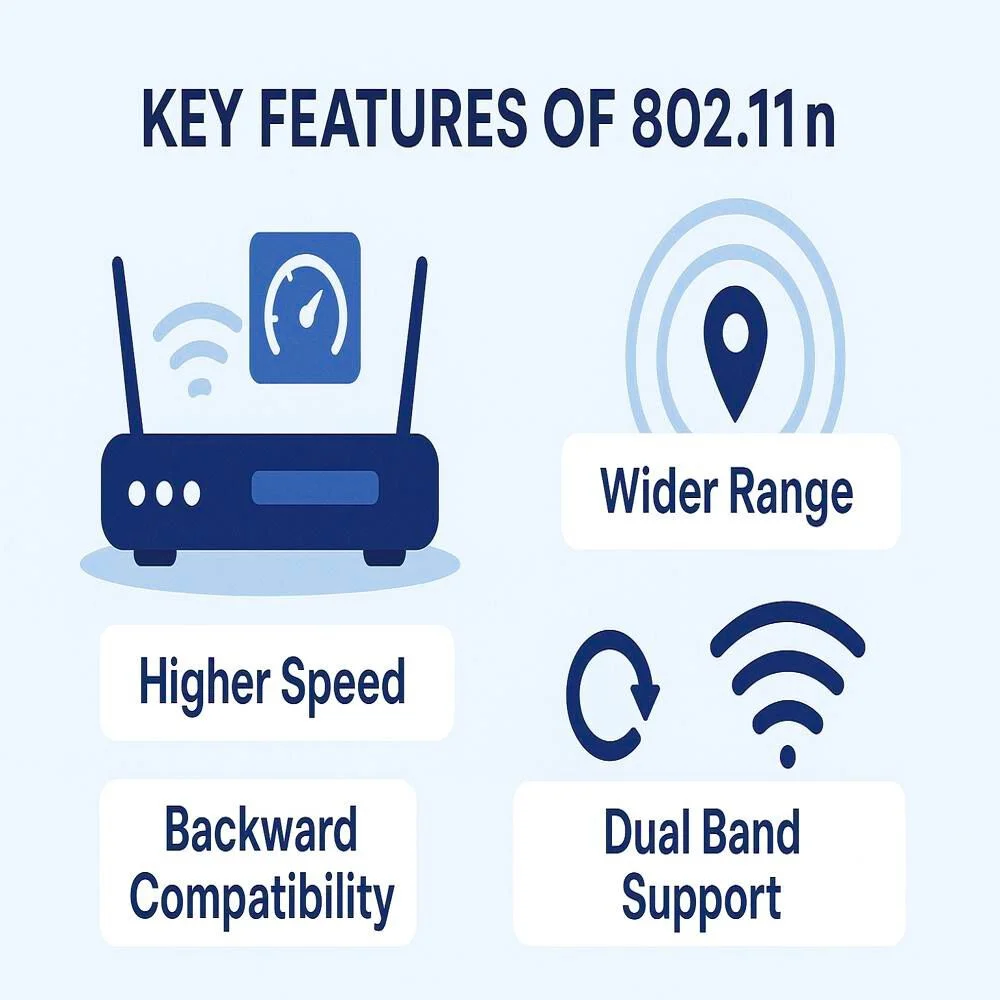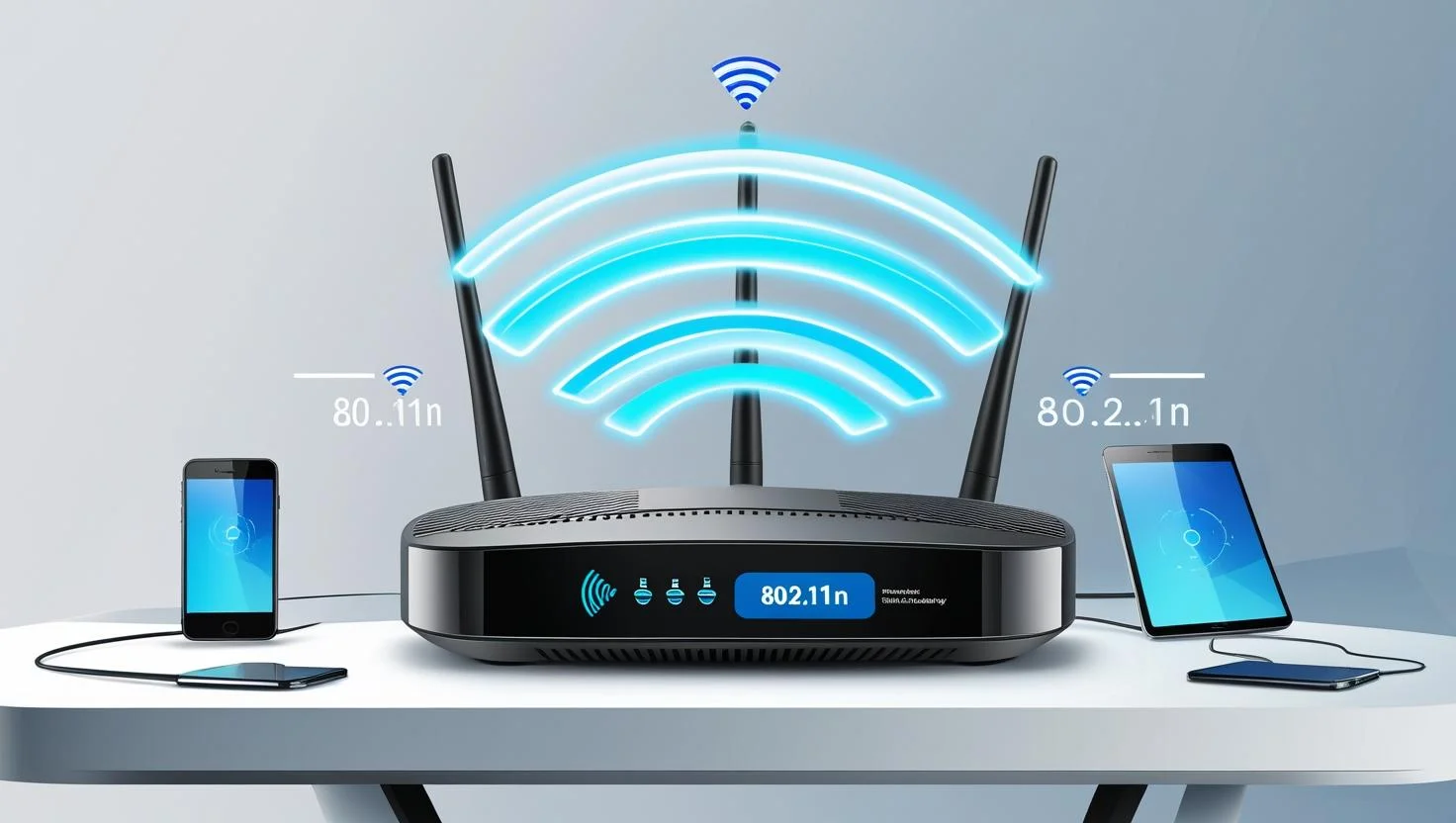802.11n, also known as Wi-Fi N, is a wireless networking standard developed by the IEEE (Institute of Electrical and Electronics Engineers). Introduced in 2009, it significantly improved Wi-Fi performance compared to earlier versions like 802.11a, b and g. With faster speeds and better range, 802.11n became a popular choice for home, office and public wireless networks.
Why 802.11n Was a Game-Changer?
This Wi-Fi version allowed users to stream HD videos, play online games and make video calls more smoothly. Unlike previous Wi-Fi standards, it supported higher data transfer rates and reduced buffering and lag. This made it ideal for modern internet use, offering a more stable and reliable connection across multiple devices.
How it Works?
802.11n Wi-Fi works on both 2.4GHz and 5GHz frequencies, which helps reduce signal disruptions and improves overall network stability. It features MIMO (Multiple Input, Multiple Output), using several antennas to send and receive more data at once resulting in better speed and wider coverage. Another upgrade is channel bonding, which merges two smaller channels into one larger one for faster data flow, making your internet experience much smoother.
Key Features of This Technology
802.11n brought many improvements that changed how we use the internet. Here are some of the most useful features:

- Higher Speed: It can offer speeds up to 600 Mbps in ideal conditions. That’s much faster than 802.11g, which offered just 54 Mbps.
- Wider Range: It can cover larger areas thanks to MIMO technology, which makes signals stronger and more reliable.
- Backward Compatibility: It can work with older Wi-Fi devices using 802.11a/b/g standards, so you don’t have to replace everything.
- Dual Band Support: It uses both 2.4 GHz and 5 GHz frequencies, giving you better options for different uses.
Thanks to these improvements, 802.11n became a reliable and efficient option for both home users and workplace environments. Whether you’re streaming a movie, attending a video call, or downloading large files, it can handle it all without slowing down too much.
Why 802.11n Technology Became So Popular?
Before 802.11n, internet speeds were slow, especially with many connected devices. As streaming and smart devices grew, users needed better Wi-Fi. Introduced around 2009, 802.11n offered faster, more stable connections at an affordable price. It became a standard feature in most routers and remains widely used today, especially in budget setups or areas with basic internet needs.
Comparing 802.11n with Other Wi-Fi Standards
Wi-Fi standards are always improving. Each new version adds something better. Here’s a quick look at how 802.11n compares to others:
- 802.11b: Much slower, with speeds up to 11 Mbps. Uses only 2.4 GHz and can be easily interfered with.
- 802.11g: Improved to 54 Mbps but still limited in range and speed compared to 802.11n.
- 802.11n: Big jump in speed and reliability. Supports MIMO, dual-band, and wider channels.
- 802.11ac: Even faster, up to 1 Gbps or more. It mainly operates on the 5 GHz frequency and is designed to work with a greater number of antennas for enhanced performance.
- 802.11ax (Wi-Fi 6): Latest version with higher efficiency, better battery life for connected devices and stronger performance in crowded areas.
So, while 802.11n was a big deal in its time, newer standards have taken its place in modern networks. Still, many homes and businesses use 802.11n because it works well enough for daily needs.
Advantages of 802.11n Wi-Fi in Daily Use
Let’s look at how 802.11n helps in everyday internet use:
- Streaming: You can watch HD videos without frequent buffering.
- Gaming: Online gaming becomes smoother, though newer Wi-Fi types are better for competitive play.
- Video Calls: Clearer video and fewer drops during online meetings or calls.
- Multiple Devices: It can handle more users at once compared to older Wi-Fi.
- File Transfers: Quicker uploading and downloading of photos, videos, or documents.
All of these things make our digital lives easier. Whether it’s working from home, attending online classes, or simply scrolling social media, 802.11n gives a reliable experience.
How to Know If You’re Using 802.11n Standard?
If you’re unsure about what Wi-Fi version you’re using, there are a few easy ways to check:
- Router Label: Look at the back or bottom of your Wi-Fi router. It may say 802.11n or “Wi-Fi N”.
- Device Settings: On your laptop or phone, go to network settings and check Wi-Fi details. Some devices show the connected Wi-Fi standard.
- Manufacturer Info: Search your router model online to find what standards it supports.
If you see “N” mentioned, then you’re using 802.11n. Some modern devices might support newer standards like AC or AX, which are faster but still compatible with N.
Should You Still Use 802.11n Wi Fi Today?
While 802.11n still works fine for many users, it may not be enough if you have a smart home or several people streaming and downloading at the same time. If your internet feels slow, upgrading to a newer Wi-Fi standard like 802.11ac (Wi-Fi 5) or Wi-Fi 6 can make a big difference. However, if you’re using a basic internet plan or only need Wi-Fi for light browsing and emails, 802.11n is more than enough.
Conclusion
802.11n was a big step forward in wireless technology. It gave us faster speeds, stronger connections and the ability to use multiple devices at once without frustration. While it’s no longer the newest Wi-Fi standard, it still plays an important role in many homes and small offices around the world. Whether you’re streaming movies, attending Zoom meetings, or just browsing the web, 802.11n delivers a reliable and smooth experience.



